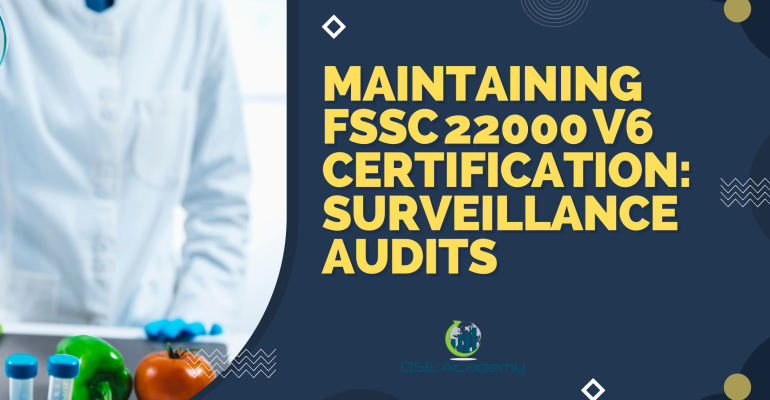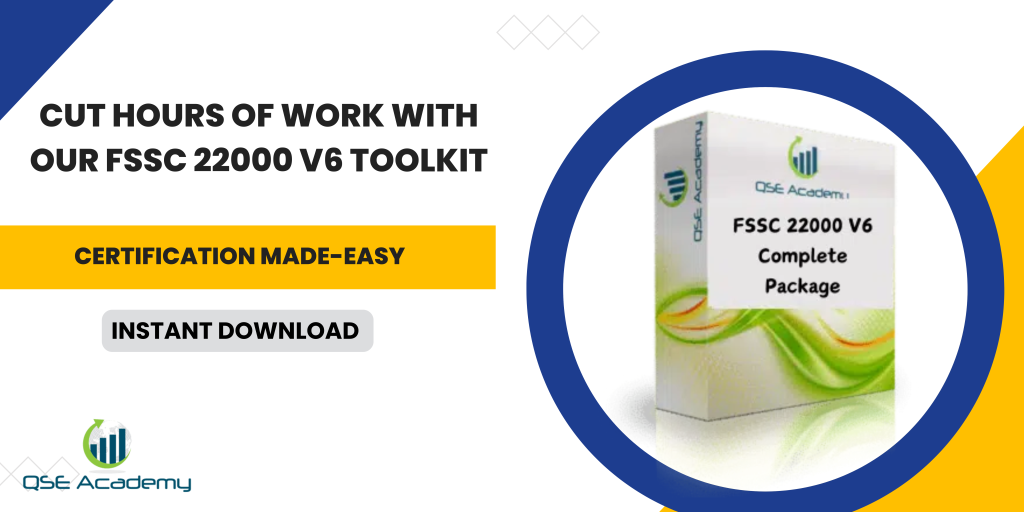Maintaining FSSC 22000 V6 Certification: Surveillance Audits
Certification Isn’t the Finish Line — It’s the Start of Continuous Compliance
Getting certified to FSSC 22000 V6 is a major achievement. But staying certified?
That’s where the real work begins.
I’ve seen many companies celebrate their Stage 2 success and then relax—until the next audit reminder lands in their inbox. The reality is that FSSC certification runs on a three-year cycle, and your surveillance audits are what keep that certificate valid.
Think of them as your annual health check: consistent, necessary, and much easier when you stay on top of things year-round.
In this guide, I’ll walk you through what to expect, how to prepare, and how to keep your certification strong with confidence and structure.
Understanding the Surveillance Audit Cycle
Once your initial certification is issued, you enter a three-year cycle:
- Year 1: Surveillance Audit 1
- Year 2: Surveillance Audit 2
- Year 3: Recertification Audit (a full system re-evaluation)
Each surveillance audit checks whether your food-safety management system is still working effectively. They’re not a re-certification—but they’re just as important.
Your audit window usually falls within 12 months of your previous audit, with a 3-month leeway on either side. Miss that window, and you risk suspension or withdrawal of your certificate.
Pro Tip: Schedule your next surveillance audit the same day you receive your certificate. It’s one less thing to chase later.
Common Mistake: Waiting for your certification body to remind you. They’ll send a notice—but if you miss the window, you’re still responsible.
 What Auditors Look for During Surveillance Audits
What Auditors Look for During Surveillance Audits
Surveillance audits aren’t about catching you off guard—they’re about checking consistency.
Auditors want to see that your system is alive, improving, and embedded in your daily operations.
Here’s what they focus on:
- Follow-up on previous non-conformities. Have you closed them properly and on time?
- Internal audit and management review results. These show leadership engagement and system performance.
- PRP and OPRP records. Are they maintained, complete, and effective?
- Training and competence. Have new or reassigned staff been trained appropriately?
- Food-safety culture implementation. A new emphasis in V6—auditors want to see real, not symbolic, action.
- Supplier control and traceability. Are suppliers monitored and recall tests performed?
Pro Tip: Keep a simple “audit evidence folder” updated monthly. Store records like calibration logs, supplier checks, and training attendance there.
Example: One of our clients—a sauce manufacturer—used a shared folder for monthly PRP logs. During their audit, they found every record in seconds and avoided a potential non-conformity.
Preparing for Your Next Surveillance Audit
Preparation isn’t about cramming at the last minute—it’s about maintaining readiness all year.
Here’s a simple rhythm that works:
- Review last audit findings. Confirm every corrective action is implemented and verified.
- Run internal audits. At least once a year, preferably every six months for dynamic processes.
- Hold a management review. Discuss food-safety performance, objectives, and improvement plans.
- Update your hazard analysis and PRPs. Reflect new ingredients, processes, or regulatory changes.
- Train your team. Keep competence records current and practical.
Pro Tip: Treat internal audits as “mini rehearsals.” Simulate interviews, walk the floor, and test traceability.
Common Pitfall: Updating documentation only a week before the audit—auditors spot rushed systems instantly.
Handling Non-Conformities and Continuous Improvement
Every company gets non-conformities—it’s normal. What matters is how you respond.
Auditors evaluate not only the fix but also how you ensure it doesn’t happen again.
Here’s how to handle them properly:
- Perform root-cause analysis (RCA). Go beyond symptoms—ask “why” until you hit the true cause.
- Create a corrective-action plan. Include responsibility, deadline, and verification method.
- Implement and verify. Don’t just close actions on paper—show evidence of real improvement.
- Submit evidence to your certification body. Usually within 30 days for minor NCs.
Pro Tip: Use a simple digital corrective-action tracker—it makes follow-ups easier.
Example: A food logistics client we worked with reduced repeat NCs by 50% after moving to a QMS platform that automatically flagged pending actions before audit time.
Managing Scheme Updates and Version Transitions
FSSC doesn’t stand still. New versions, interpretations, and guidance notes roll out regularly.
Staying updated keeps your system compliant and audit-ready.
Here’s how to stay on top of changes:
- Subscribe to the FSSC Foundation newsletter.
- Follow your accreditation body (AB) or certification body for updates.
- Conduct a quick gap analysis every time a version changes (like from V5.1 to V6).
- Update training programs for internal auditors and team leads.
Pro Tip: Don’t wait until the next audit to apply new requirements. Implement them early, and show auditors your proactive approach.
Building a Culture of Ongoing Compliance
Sustained certification depends on people, not paperwork.
When food safety becomes part of daily routines, surveillance audits turn into straightforward reviews rather than stressful inspections.
Encourage ongoing engagement by:
- Conducting monthly hygiene or GMP audits.
- Holding quick “toolbox talks” about food-safety culture topics.
- Having managers do walk-throughs and ask simple process questions.
- Recognizing teams that proactively solve quality issues.
Example: One of our bakery clients started short weekly “clean zone checks” led by supervisors. Within months, audit findings dropped by 70%, and morale improved because ownership increased.
Pro Tip: Don’t treat food safety as an event—it’s a mindset reinforced daily.
FAQs: Maintaining FSSC 22000 V6 Certification
Q1. What happens if we miss our surveillance audit window?
Your certificate can be suspended or withdrawn. If that happens, you’ll likely need a full recertification audit to regain it.
Q2. Can we combine surveillance audits with ISO 9001 or ISO 14001?
Yes, absolutely. Integrated audits reduce man-days and improve efficiency—many clients save 20–30% of audit time this way.
Q3. How soon do we get audit results?
Usually within 10–15 days after the closing meeting, depending on your certification body’s internal review process.
Keep Certification Alive Through Routine Excellence
Passing your initial FSSC 22000 audit is just the start.
Maintaining certification means embedding continuous improvement into your everyday work. When your team sees food safety as part of the culture—not just an audit event—surveillance visits become a validation of your consistency, not a source of anxiety.
At QSE Academy, we help companies stay compliant year-round through practical checklists, audit-readiness templates, and gap-analysis tools built for real operations.
Melissa Lavaro is a seasoned ISO consultant and an enthusiastic advocate for quality management standards. With a rich experience in conducting audits and providing consultancy services, Melissa specializes in helping organizations implement and adapt to ISO standards. Her passion for quality management is evident in her hands-on approach and deep understanding of the regulatory frameworks. Melissa’s expertise and energetic commitment make her a sought-after consultant, dedicated to elevating organizational compliance and performance through practical, insightful guidance.








